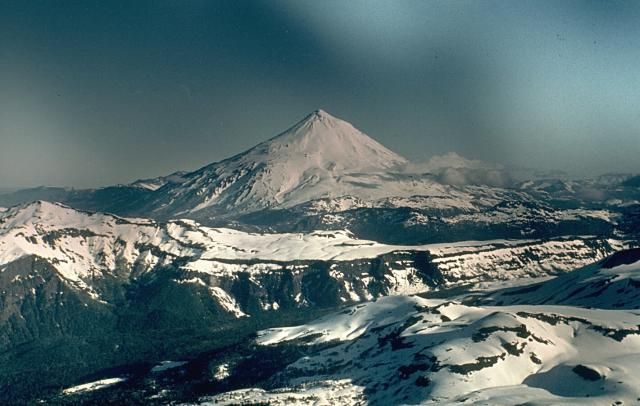Lanin (Chile-Argentina)
Status Normal Eruption 560 3776m
Stratovolcano (Subduction zone / Continental crust (> 25 km))

Lanín is a large conical late-Pleistocene to Holocene stratovolcano along the Chile-Argentina border. The dominantly effusive basaltic-to-trachydacitic volcano lies at the eastern end of a NW-SE-trending volcanic group beginning with Villarrica that is transverse to the Andean chain. The beautifully symmetrical, 3776-m-high Lanín rises 2500 m above its base; shoulder areas on the upper flanks hint at a buried caldera. The volcano was formed in four eruptive stages dating back to the early Pleistocene or late Pliocene. The last two stages occurred during the late-Pleistocene and Holocene. A small lava dome at the summit fed blocky lava flows to the north about 2200 years ago. Lanín was reported active after an earthquake in 1906, but Sapper (1917) stated that newspaper accounts are strongly disputed, and no historical eruptions are known. A postglacial tuff ring (Volcán Arenal) is located below the SW flank in Argentina. A younger lava flow from Lanín covers deposits of Volcán Arenal and extends south into Lago Paimún.
Volcán Lanín is a large conical late-Pleistocene to Holocene stratovolcano along the Chile-Argentina border. The beautifully symmetrical, 3737-m-high Lanín, seen here from the Chilean side, rises 2500 m above its base. A small lava dome at the summit fed blocky lava flows to the north. A postglacial tuff ring (Volcán Arenal) is located below the SW flank of Lanín in Argentina. A younger lava flow from Lanín covers deposits of Volcán Arenal and extends south into Lago Paimún. No reliable reports of historical eruptions from Lanín are known.
Photo by John Davidson, University of Michigan (courtesy of Hugo Moreno (University of Chile).
Last updated 2019-08-04 00:28:03

Camera
Latest activity
Aww Error :(
Data not available